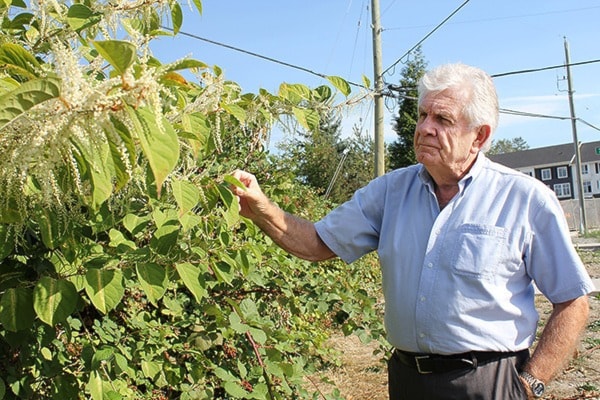A South Surrey resident is raising the alarm over an invasive plant he recently discovered near his home.
Mardie Wolsey was picking blackberries with his grandchildren at 26 Avenue and Cranley Drive, near Sunnyside Park, when a suspicious-looking plant caught his eye.
Having recently read an article in Macleans about Japanese knotweed – and how it is aggressively taking over certain parts of the province – Wolsey recognized its broad green leaves, round, bamboo-like stems and small white flowers.
After sending pictures of the plant to the provincial forest ministry’s invasive plant department, Wolsey’s suspicions were confirmed.
“They thanked me for noticing it, and confirmed that it is knotweed,” Wolsey said. “They told me that they will get at it, and I hope they do. It’s wicked stuff.”
According to Jennifer Grenz, project manger with the Invasive Species Council of Metro Vancouver, Japanese knotweed poses a “huge risk” to the local environment and infrastructure.
“It’s capable of upheaving concrete, cracking foundations,” Grenz told Peace Arch News. “It’s something that’s happened to such an extent in the U.K. that people are being denied insurance and mortgages because of it. It’s only a matter of time over here before that begins to be an issue.”
The council has been working over the past five years to bring together municipalities, the province and federal representatives – as well as utility companies like BC Hydro and Fortis – to battle the knotweed infestation around B.C.
Grenz said that educating private residents about the dangers of knotweed – and how to eradicate it – is “the last piece of the puzzle” in the battle against the invasive plant.
The ISCMV has set up a website – www.knotonmyproperty.com – which provides information about knotweed, and the dos and don’ts of dealing with it.
Among the don’ts, Grenz notes, is cutting or digging out the weed.
“A lot of the spread that occurs is because of poor choices in management,” she said, noting that knotweed has a “massive” root system, and what you see above ground is a small portion of the full plant.
“You need a herbicide that will move all the way through the plant into the humungous root system, either by way of injection guns or spraying or wiping the plant, depending on where it is.”
According to Nadia Chan, natural areas co-ordinator for the City of Surrey, an eradication program has been in place throughout the city’s parks for 10 years. Additionally, a program to remove knotweed from city roadsides was put in place two years ago.
“We identify locations with the knotweed and put them on a scheduled program for eradication and follow-up maintenance,” Chan told PAN, noting the plant is treated with stem injections or spraying throughout July and August. “We follow up with yearly monitoring on all those sites and provide treatment the second and third year, if required.”
Chan said Surrey is currently managing knotweed in about half of the city’s natural area parks, noting some sites are simply a few stems whereas others are a few square metres of plant.
“Roadside sites tend to be larger because the plant is very easily spread by mowing,” she pointed out.
Surrey residents who spot Japanese knotweed on city property are asked to call the parks service request line at 604-501-5050; for knotweed on private property, Chan recommended contacting the ISCMV.
For Wolsey, whose townhouse is less than a block from where he discovered the knotweed, getting the problem under control in his neighbourhood needs to be a priority before homes become affected.
“People around here should be notified so that they can keep their eyes out for it,” he said.
